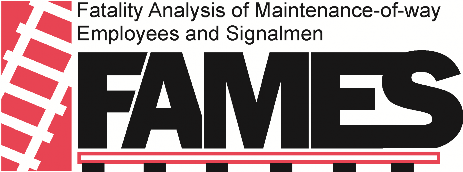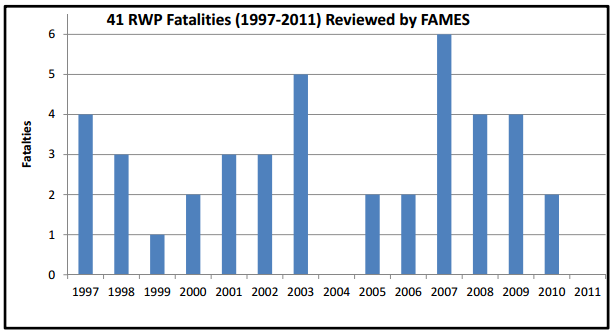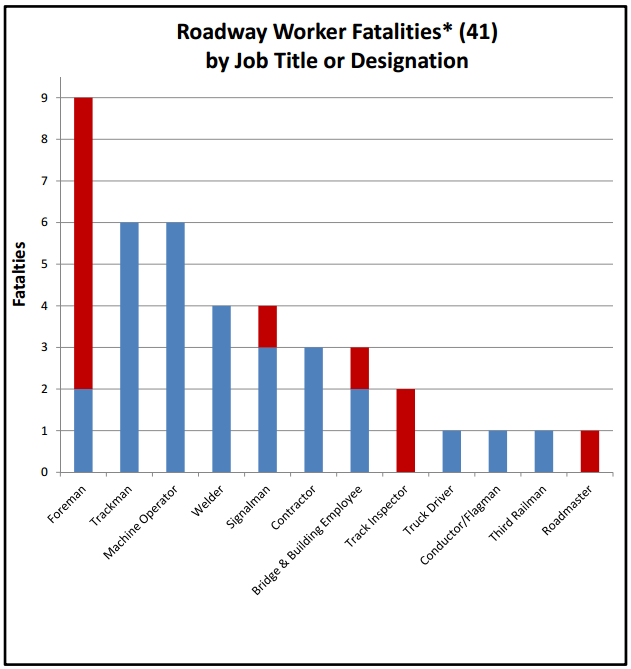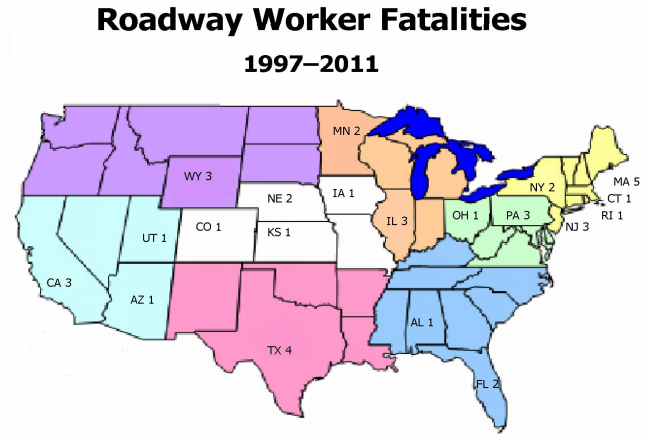Introduction to FAMES Committee Published: Oct 30 2015 12:10PM

Dedication: The FAMES Committee dedicates its efforts to all roadway workers who have lost their lives in the performance of duty and to the families, loved ones, and coworkers they have left behind. Mission Statement: The Mission of the Fatality Analysis of Maintenance-of-way Employees and Signalmen (FAMES) Committee is to analyze all fatalities and selected related incidents in order to make recommendations to reduce the risk of future occurrences and eliminate fatalities to roadway workers. On April 24, 2009, the Federal Railroad Administration (FRA) invited railroad labor and management representatives to Washington, D.C., to form an ad-hoc committee to review roadway worker fatalities which occurred since January 1997.
1 Additionally, the Committee was tasked with reviewing roadway worker fatalities at highway-rail grade crossings that are not classified as RWP events. The Committee became known as the Fatality Analysis of
Maintenance-of-way Employees and Signalmen (FAMES).
FAMES is a voluntary, consensus-based Committee focused on identifying risks, trends, and factors impacting roadway worker safety. FAMES will periodically issue findings and recommendations based upon its review of available safety data. The Committee’s activities are focused on education and prevention. The findings and recommendations of FAMES are separate from the regulatory process.
To date, FAMES analyzed available data from 39 roadway worker accidents that occurred between January 1997 and the end of 2011, in which 41 roadway workers perished. The graph below categorizes the 41 RWP fatalities by year:
 Dedication
Dedication The FAMES Committee dedicates its efforts to all roadway workers who have lost their lives in the performance of duty and to the families, loved ones, and coworkers they have left behind.
Mission Statement
The Mission of the Fatality Analysis of Maintenance-of-way Employees and Signalmen (FAMES) Committee is to analyze all fatalities and selected related incidents in order to make recommendations to reduce the risk of future occurrences and eliminate fatalities to roadway workers.
Purpose and Scope
The purpose of FAMES is to achieve the goal of zero roadway worker fatalities by:
- Identifying risk factors through data analysis.
- Presenting the analysis and findings of the FAMES Committee to YOU, the railroad worker.
- Providing recommendations on improving the safety of roadway workers who perform
work on or near the tracks.
- Providing recommendations to eliminate roadway worker fatalities at highway-rail grade crossings that are not classified as RWP events.
- Encouraging implementation of improved safety practices.
The scope of FAMES’ research activities is to analyze available data related to roadway worker fatalities.
FAMES Analysis Process
The FAMES Committee includes 23 individuals from labor, management, and FRA with more than 600 years of collective rail industry experience. As of May 2012, the Committee held 22 separate meetings encompassing 50.5 days to review 39 fatal roadway worker accidents. On average, FAMES devoted approximately 10.4 hours examining and analyzing each of the 39 fatal incidents. Additional cases, including those involving fatalities to signalmen and other 3 roadway workers struck by highway motor vehicles at highway-rail grade crossings, are slated for analysis in the near future.
Below is a brief description of the data-driven analysis process employed by FAMES:
1) Case Selection: FRA initially provided FAMES with 39 accident investigation reports from 1997 through 2011, involving 41 roadway workers who were fatally injured when they, or their equipment, were struck by a train or other on-track equipment.
2) Case File Review Includes:
- FRA Accident Reports
- FRA Interview Reports
- FRA Inspection Reports
- Eyewitness Reports
- Coroner Reports
- Police Reports
- Toxicology Reports
- Google Earth
- Internet-Archived Weather Information
- Sketches and Photos
- Operating Rules
- Railroad Timetables
- National Archive Reports
- Employee Statements
- Work/Rest Schedules
- Employee Contacts
- First-Hand Knowledge
3) Case Review: FAMES follows four principal steps in reviewing cases:
a) Review of case file: Each member of FAMES independently reviews the case file. FAMES then reviews the case as a group.
b) Recording the facts: With group consensus, quantitative and narrative case information is entered into a relational database system2 developed for that purpose. This includes information such as weather conditions, employee information, work activity, track topography, equipment, employee training and experience, and other pertinent facts.
c) Discussion of the facts: After each case review, the team discusses the facts regarding operating characteristics, conditions, and events to understand the circumstances of each fatal accident.
d) Agreement: FAMES discusses each case until there is consensus agreement on Possible Contributing Factors (PCF) and External Circumstances (EC).
- PCFs are those factors that could have possibly been mitigated by some action or decision by one or more roadway workers or managers. More simply put; something that may have prevented the fatality (example: better training).
- ECs are those circumstances that exist but cannot be mitigated by some action or decision (example: weather conditions).
The FAMES team does not rank these factors. They are cataloged in a database to help identify commonalities or trends.
4) Analysis — Searching for Commonalities: Commonalities are shared characteristics among cases that may lead to a common solution. Commonalities discovered through this process lead to case classifications and recommendations.
5) Classification of Cases: After completing an extensive analysis of each case, the FAMES Committee groups those cases based upon PCFs, ECs, and other commonalities into subjectspecific classifications for further investigation. The initial five classifications identified by FAMES, as of May 2012, are:
- Fatalities to Roadway Workers-in-Charge and Lone Workers
- Fatalities where Roadway Maintenance Machines were present
- Fatalities on adjacent track
- Fatalities where an adjacent track was present
- Fatalities where on-track safety briefings were implicated
6) Reports and Recommendations: With consensus of the team, FAMES develops subjectspecific, data-driven reports. FAMES reports include facts, commonalities, statistics and recommendations which are intended as educational tools to reduce the risk of future occurrences and eliminate RWP fatalities.
Description of a Roadway Worker
A roadway worker is any employee of a railroad, or of a contractor to a railroad, whose duties include inspection, construction, maintenance, or repair of railroad track, bridges, roadway, signal and communication systems, electric traction systems, roadway facilities or roadway maintenance machinery on or near track or with the potential of fouling a track, and flagmen and watchmen/lookouts for roadway workers.
Roadway Worker Fatalities
Following implementation of the RWP Rule in 1997, there have been a total of 42 fatal RWP accidents, in which 44 roadway workers have perished, as of December 31, 2011. The FAMES Committee was able to obtain data to analyze 39 fatal RWP accidents, which accounted for 41 of the 44 fatalities. The FAMES Committee analysis is based on the available data.
The graph below categorizes the 41fatalities, by job title or designation, analyzed by FAMES:
Following the implementation of the Roadway Worker Protection (RWP) Rule in 1997, there have been a total of 42 fatal RWP accidents, in which 44 roadway workers have perished, as of January 1, 2012. The FAMES Committee was able to obtain data to analyze 39 fatal RWP accidents, which accounted for 41 of the 44 fatalities. The FAMES Committee analysis is based on the available data. For purposes of this report, “RMMs Present” means one or more Roadway Maintenance Machines (RMMs) were working within the fatally injured employee’s work group at the time of the accident.
At least one RMM was present in 22 of the 41 roadway worker fatalities reviewed. The chart below indicates the number of fatalities where RMMs were present and how many RMMs were present in each of the 22 fatalities.
 * The 12 fatally injured employees indicated in red above were responsible for (1) providing on-track safety for members of a work group group or (2) providing on-track safety for themselves as a lone worker at the time of the accident.
* The 12 fatally injured employees indicated in red above were responsible for (1) providing on-track safety for members of a work group group or (2) providing on-track safety for themselves as a lone worker at the time of the accident. Further information regarding the location of the 41 roadway worker fatalities analyzed by FAMES is provided in the the following map:

The following table shows the location of fatally injured employees and whether the fatally injured employees were struck by a RMM or train.
Moving Forward
FAMES will continue to meet regularly and issue periodic reports and recommendations concerning specific roadway worker safety issues. It is the goal of every FAMES participant that our work will help raise safety awareness, promote a strong safety culture, and contribute to the broader effort to eliminate roadway worker fatalities through education and heightened awareness.
FAMES Participants and affiliations
American Public Transportation Association - Bill Grizard
American Short Line and Regional Railroad Association - Tom Streicher
Association of American Railroads - Mike Lesniak
BNSF Railway - Arthur Charrow
Brotherhood of Maintenance of Way Employes Division - Jed Dodd, Rick Inclima, David Joynt
Brotherhood of Railroad Signalmen - Jerry Boles, John Bragg, Jim Finnegan, Kelly Haley, Joe Mattingly
CSX Transportation - Charles Strickland
Farmrail System, Inc. - J. R. Gelnar
Federal Railroad Administration - David Kannenberg, Joe Riley, Ken Rusk, Kevin Snyder, Michael Woods
National Railroad Passenger Corporation (Amtrak) - Steve Falkenstein, Dennis Fencil
Norfolk Southern Railway - Brad Kerchof
Union Pacific Railroad - Bobby Odom
1 The date FRA Roadway Worker Protection (RWP) regulations became effective.
2 The FAMES database system was acquired from the SOFA Working Group and subsequently modified to meet the needs of the FAMES Committee. The Switching Operations Fatality Analysis (SOFA) Working Group is a voluntary, non-regulatory, workplace-safety partnership, which was formed to study the fatalities that occur during railroad switching operations and to develop findings and recommendations that will prevent railroad employee deaths.
The FAMES Committee consists of safety representatives from a cross section of rail labor, railroad management, and federal regulators. FAMES is a continuous improvement process that relies on the candid sharing of available data and the views of its participants. To enable the process, FAMES explicitly refrains from making any findings regarding whether any past or present practice or protocol satisfies any legal duty or standard of care.
The views, opinions, and recommendations contained in this report are those of the FAMES Committee and do not necessarily represent the views, opinions, or recommendations of any specific railroad, labor organization, or governmental agency.